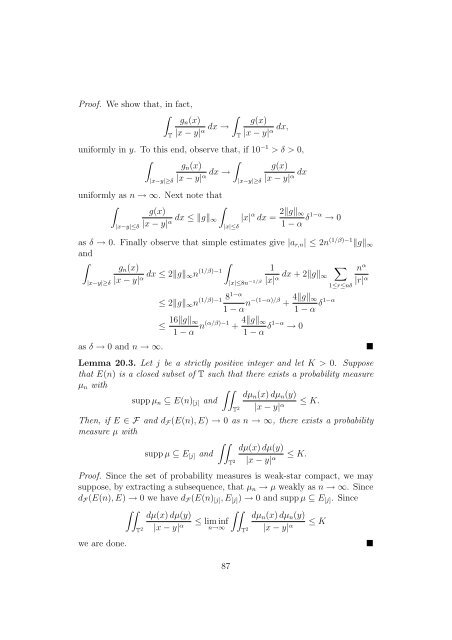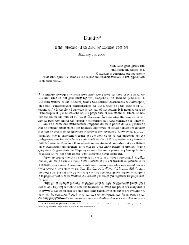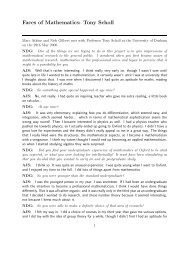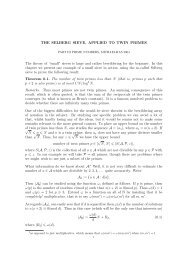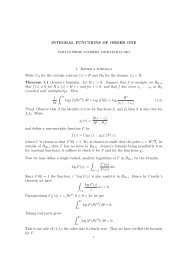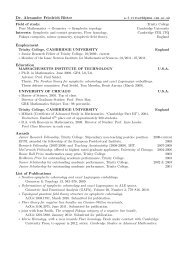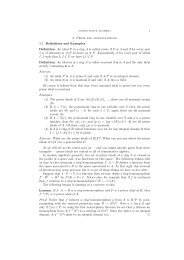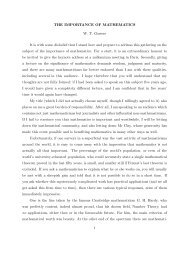Baire Category, Probabilistic Constructions and Convolution Squares
Baire Category, Probabilistic Constructions and Convolution Squares
Baire Category, Probabilistic Constructions and Convolution Squares
Create successful ePaper yourself
Turn your PDF publications into a flip-book with our unique Google optimized e-Paper software.
Proof. We show that, in fact,<br />
<br />
<br />
gn(x)<br />
dx →<br />
|x − y| α<br />
T<br />
|x−y|≥δ<br />
T<br />
g(x)<br />
dx,<br />
|x − y| α<br />
uniformly in y. To this end, observe that, if 10−1 > δ > 0,<br />
<br />
<br />
gn(x)<br />
dx →<br />
|x − y| α<br />
g(x)<br />
dx<br />
|x − y| α<br />
uniformly as n → ∞. Next note that<br />
<br />
<br />
g(x)<br />
dx ≤ g∞<br />
|x − y| α<br />
|x−y|≤δ<br />
|x|≤δ<br />
|x−y|≥δ<br />
|x| α dx = 2g∞<br />
1 − α δ1−α → 0<br />
as δ → 0. Finally observe that simple estimates give |ar,n| ≤ 2n (1/β)−1 g∞<br />
<strong>and</strong><br />
<br />
|x−y|≥δ<br />
<br />
gn(x)<br />
(1/β)−1<br />
dx ≤ 2g∞n<br />
|x − y| α<br />
|x|≤8n−1/β 1<br />
|x|<br />
α dx + 2g∞<br />
(1/β)−1 81−α<br />
≤ 2g∞n<br />
1 − α n−(1−α)/β + 4g∞<br />
1 − α δ1−α<br />
≤ 16g∞<br />
1 − α n(α/β)−1 + 4g∞<br />
1 − α δ1−α → 0<br />
<br />
1≤r≤nδ<br />
n α<br />
|r| α<br />
as δ → 0 <strong>and</strong> n → ∞. <br />
Lemma 20.3. Let j be a strictly positive integer <strong>and</strong> let K > 0. Suppose<br />
that E(n) is a closed subset of T such that there exists a probability measure<br />
µn with<br />
suppµn ⊆ E(n)[j] <strong>and</strong><br />
<br />
T 2<br />
dµn(x)dµn(y)<br />
|x − y| α<br />
≤ K.<br />
Then, if E ∈ F <strong>and</strong> dF(E(n),E) → 0 as n → ∞, there exists a probability<br />
measure µ with<br />
<br />
dµ(x)dµ(y)<br />
suppµ ⊆ E[j] <strong>and</strong><br />
≤ K.<br />
|x − y| α<br />
Proof. Since the set of probability measures is weak-star compact, we may<br />
suppose, by extracting a subsequence, that µn → µ weakly as n → ∞. Since<br />
dF(E(n),E) → 0 we have dF(E(n)[j],E[j]) → 0 <strong>and</strong> suppµ ⊆ E[j]. Since<br />
<br />
T 2<br />
dµ(x)dµ(y)<br />
≤ lim inf<br />
|x − y| α n→∞<br />
T 2<br />
<br />
T 2<br />
dµn(x)dµn(y)<br />
|x − y| α<br />
≤ K<br />
we are done. <br />
87


